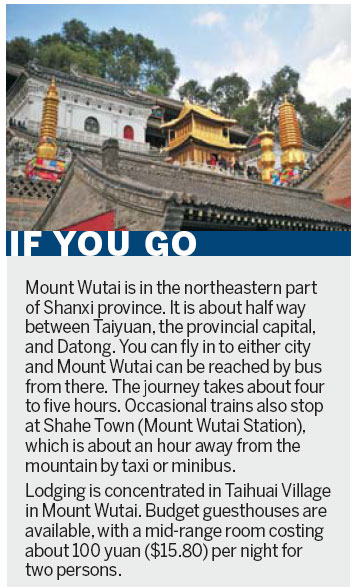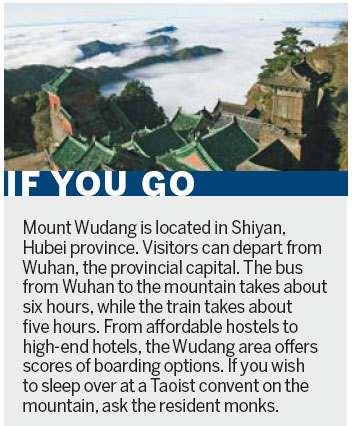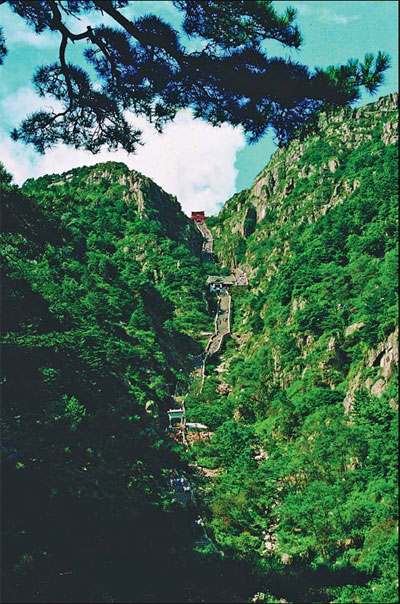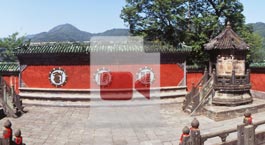Climb, play and pray
By Sun Ye ( China Daily )
Updated: 2012-10-05
|
Mount Wudang in Hubei province offers visitors fine examples of the Ming Dynasty (1368-1644) monastic architecture. Provided to China Daily |
What better way to recharge than to find a retreat away from the hustle and bustle of the cities? Sun Ye picks out five holiday destinations that offer religious respite as a panacea for modern maladies.
Editor's note: China is known for its mountainous religious retreats where the many major beliefs first came to life. The most famous are the abode of the Shaolin monks, and the home of the Wudang Taoists, but there are many more noteworthy hill retreats that attract the modern pilgrims who go there not just for renewal of peace of mind, but the serene scenery.
Mount Wutai

While in Wutai, you have to visit the temples. The mountain is home to many of China's most important monasteries and temples. Inscribed as a UNESCO World Heritage Site, Wutai boasts 53 sacred venues. It is also believed to be the ashram, or spiritual hermitage, of the Bodhisattva of wisdom, Manjusri (or Wenshu in Chinese).
First on the list is Nanshan Temple. First built in the Yuan Dynasty (1271-1368), the temple complex has seven terraces, which are then divided into three parts. The lower three terraces form the Jile Temple, the middle terrace is the Shande Hall and the top three terraces become the Youguo Temple. All are worthy of a climb, fuelled with a pious heart.
You should also visit Pusa Peak, where the Bodhisattva of wisdom once resided. This is where you can pray for good luck and a prosperous life for your family.
If what you are after is more physical splendor, then arrange for a visit to Xiantong Temple. This large showcase of Buddhist architecture from the Qing Dynasty (1644-1911) is spread over 43,700 square meters and houses more than 400 rooms.
Mount Wutai, as its name suggests, consists of five peaks (North, South, East, West, Central), and all are accessible. There are enough monasteries and temples on each to make every ascent memorable.
Nedong County, Tibet

Nedong County in Shannan prefecture, in Tibet autonomous region, is an oasis of tranquility. It's home to the region's first palace as well as Tibet's first formal Buddhist monastery. The place is also known as the cradle of Tibetan history and culture.
The Samye Monastery built in the eighth century is Tibet's oldest and was the site of the "the Great Debate" (AD 792-794) between the Indian Mahayanists and Chinese Zen Buddhists. Founded during the reign of King Trisong Detsen, with the help of the Indian Buddhist masters Padmasambhava and Shantarakshita, it is widely believed to be Tibet's first formal Buddhist monastery.
All four major sects of Tibetan Buddhism share presence in Samye.
Another must-see in the region is Yambulakang, the first Tibetan palace. The palace perched precariously on the top of Mount Tashitseri, overlooking the Yarlung Zangbo River valley, which is considered the place of origin of Tibetan civilization. The palace was built more than 2,000 years ago by Nyatri Tsenpo, the first Tibetan king.
Shaolin Temple

As the birthplace of Chinese martial arts and Zen Buddhism, Shaolin Temple boasts a wealth of cultural relics which makes it popular among tourists and Buddhists alike. Nestled on Mount Songshan, Shaolin Temple is believed to be at the center of the world, and therefore a repository of energy, or qi.
Take a reflective walk through the Pagoda Forest, a cemetery containing the ashes of monks stored in more than 200 pagodas and steles donated by foreign martial arts schools.
The hills west of the temple are also worth exploring, where the 750-meter-high Wuru Peak is marked by a three-story-tall, white-colored statue of Damo, the patriarch who first taught Shaolin monks martial arts and positioned the temple as the birthplace of Zen Buddhism in China.
Close to the top of Wuru lies the cave where Damo sat meditating long enough to apparently leave a shadow on the wall - that slab of cave is now housed in Shaolin Temple itself.
Mount Wudang

Wudang is the Mecca for Taoists and kung fu lovers. The site in Hubei province is known for its Taoist monasteries as well as the birthplace of a martial arts style popular the world over.
You can read Taoist scriptures and practice tai chi here or you can play observer and climb the Heavenly Pillar Peak to be involved in an ancient Taoist pilgrimage.
The scenic spots in Wudang are almost all associated with one mythological figure, the Great Emperor Zhenwu. Go to the Golden Temple and the Prince Slope to get a grip on his formidable reputation.
The Prince Slope is now dominated by buildings constructed in 1413 based on the Zhenwu scriptures. This 16,000-square-meter complex is perched on a slope of 60 degrees, with Lion's Peak as its backdrop and a waterfall and the curving road forming a natural frame.
The Yellow River Wall of Nine Curves is another must-see. The wall, 1.5 meters thick and 2.5 meters high, is said to embody the nine virtues of Taoism and will bless those who make contributions to the religion.
You don't have to be a Taoist to appreciate Wudang's beauty. Embraced by nature and its misty vicissitudes, the structures, mostly built in the Ming Dynasty (1368-1644), have an imperial grandeur, yet are toned down by simplicity and restraint.

Mount Taishan
According to many ancient Chinese creation myths, Taishan was the point from which the world originated. Today, the mountain in Shandong province is still revered both in the Buddhism and Taoist faiths. Traditional belief also maintains that each day begins with the sun rising at Taishan before it starts its westward journey across the world.
Mount Taishan rises 150 meters above sea level in the city of Tai'an to 1,545 meters at the Jade Emperor Peak. It is a World Heritage Site festooned with a chain of 22 temples, 97 ruins, 819 stone tablets and 1,018 stone inscriptions.
A journey by bus or on foot will end at Zhongtian Men (Middle Heaven's Gate), the final destination of the western route. While trekking up, you will come across a few historically significant spots, including the Longevity Bridge, which spans a small waterfall feeding the Black Dragon Pool. Ancient legends say that this lake was inhabited by submerged cities of mermen, who would occasionally pull passers-by into its depths and transform them into animals.
To see the sunset, the western side of Jade Emperor Peak is the best vantage point to watch the setting globe sink into the sea of clouds below.

(China Daily 10/05/2012 page10)




